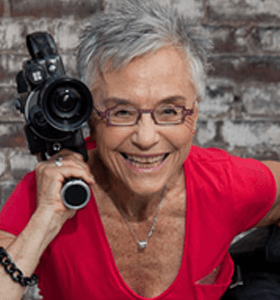Barbara Hammer
1939-2019
Barbara Hammer was born in Hollywood, California. She was a visual artist working primarily in film and video. She made over 80 moving image works in a career that spanned 40 years. She is considered a pioneer of queer cinema. She created experimental films dealing with women’s issues such as gender roles, lesbian relationships and coping with aging and family.
Hammer graduated with a bachelor’s degree in psychology and later received a master’s degree in English literature. She studied film at San Francisco State University where she first encountered Maya Deren’s Meshes of the Afternoon, which inspired her to make experimental films about her personal life.
In 1974, Hammer was married and teaching at a community college in Santa Rosa, California. Around this time she came out as a lesbian. After leaving her marriage, she “took off on a motorcycle with a Super-8 camera.” That year she filmed Dyketactics, widely considered one of the first lesbian films.
Over her career, she received numerous awards and honors. Her goal through her film work was to provoke discourse on those who are marginalized. She felt making films that show her personal experience helped start the conversation on lesbianism. Her films were regarded as being controversial because they focused on feminine taboo topics. One of her most well-known and most controversial films is Nitrate Kisses, a frank and explicit exploration of sexuality.
Hammer’s film Dyketactics (1974) illustrates the importance of the female body to her work. Hammer aimed to create an erotic film that used different film language than the mainstream, heterosexual erotic films of the time. Hammer’s early films utilized natural imagery, such as trees and fruit, to be associated with the female body. Her films commented on the fact that members of the LGBT community are often left out of history.
In 2006, Hammer was diagnosed with stage 3 ovarian cancer. After 12 years of chemotherapy, she fought for the right of self-euthanasia. She referenced this in her works, such as her 2009 film A Horse is Not a Metaphor, in which she expressed the ups and downs of a cancer patient. Through her experience, she became an advocate for Right to Die and fought for the New York Medical Aid in Dying Act.

